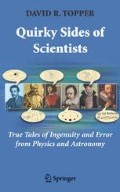Access this chapter
Tax calculation will be finalised at checkout
Purchases are for personal use only
Preview
Unable to display preview. Download preview PDF.
References
The law of projectile motion is presented in Galileo Galilei, Two New Sciences, trans. Still-man Drake (Toronto: Wall and Thompson, 1989), pp.147–148, 217–218, and 221–225. Stillman Drake and James MacLachlan, “Galileo’s Discovery of the Parabolic Trajectory,” Scientific American, 232 (March, 1975), pp. 102–110.
Galileo Galilei, Dialogue on the Two Chief World Systems, trans. Stillman Drake (Berkeley: University of California Press, 1967), pp.164–167 (for a stone falling from a tower), 190–196 (for rotational motion at the equator), and 398–399 (for the ball in a bowl of water experiment).
Galileo’s quotation on inertia is found in his “Letters on Sunspots, “reprinted in Discoveries and Opinions of Galileo, trans. Stillman Drake (New York: Doubleday, 1957), p. 113. The letter of 1637 is quoted in Stillman Drake, Galileo at Work: His Scientific Biography (Chicago: University of Chicago Press, 1978), pp. 376–379.
An alternative interpretation of circles and parabolas is by Ron Naylor, “Galileo, Coperni-canism and the Origins of the New Science of Motion,” British Journal for the History of Science, 36, No. 2 (June, 2003), pp. 151–181.
On Galileo’s concept of inertia compare, Dudley Shapere, Galileo: A Philosophical Study (Chicago: University of Chicago Press, 1974), Chapter 4 (“Galileo and the Principle of Inertia”) with Stillman Drake, Galileo Studies (Ann Arbor: University of Michigan Press, 1970), pp. 240–278, and Galileo at Work: His Scientific Biography (Chicago: University of Chicago Press, 1978), pp. 376–377.
The quotation about the Arsenal of Venice is by Ingrid Rowland, from her essay, “The Nervous Republic,” in The New York Review of Books (November 1, 2001), p. 12.
The binocular rivalry experiment is mentioned in John R. Searle, “Consciousness: What We Still Don’t Know,” The New York Review of Books (January 13, 2005), pp. 36–39.
Author information
Authors and Affiliations
Rights and permissions
Copyright information
© 2007 Springer Science+Business Media, LLC
About this chapter
Cite this chapter
Topper, D.R. (2007). Ensnared in Circles: Galileo and the Law of Projectile Motion. In: Quirky Sides of Scientists. Springer, New York, NY. https://doi.org/10.1007/978-0-387-71019-8_8
Download citation
DOI: https://doi.org/10.1007/978-0-387-71019-8_8
Publisher Name: Springer, New York, NY
Print ISBN: 978-0-387-71018-1
Online ISBN: 978-0-387-71019-8
eBook Packages: Physics and AstronomyPhysics and Astronomy (R0)

